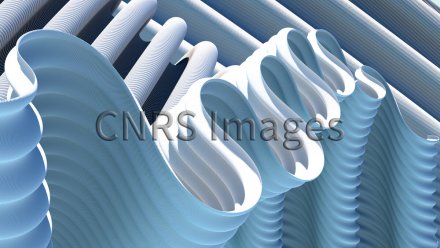Production year
2022

© V BORRELLI / R DENIS / F LAZARUS / B THIBERT / M THEILLIERE / ICJ / G-SCOP / LJK / uni. Luxembourg, soutenu par le FNR / CNRS
20220122_0012
Close-up view of a surface representing hyperbolic space and its boundary at infinity. The existence of such a surface was predicted by the mathematician John Nash in the 1950s. It has now actually been constructed, with the help of computers, by a team of scientists, who are attempting to visualise paradoxical mathematical objects. This surface, resulting from an infinite entanglement of corrugations (or folds), has an astonishing property: the shortest path between a point on its sinuous edge and any other point on this surface is infinitely long. Visualisations of this kind make it possible to explore a new geometry, half-way between that of fractals and that of ordinary surfaces: the geometry of smooth fractals. This image is one of the winners of the 2022 La preuve par l’image (LPPI) photography competition.
The use of media visible on the CNRS Images Platform can be granted on request. Any reproduction or representation is forbidden without prior authorization from CNRS Images (except for resources under Creative Commons license).
No modification of an image may be made without the prior consent of CNRS Images.
No use of an image for advertising purposes or distribution to a third party may be made without the prior agreement of CNRS Images.
For more information, please consult our general conditions
2022
Our work is guided by the way scientists question the world around them and we translate their research into images to help people to understand the world better and to awaken their curiosity and wonderment.